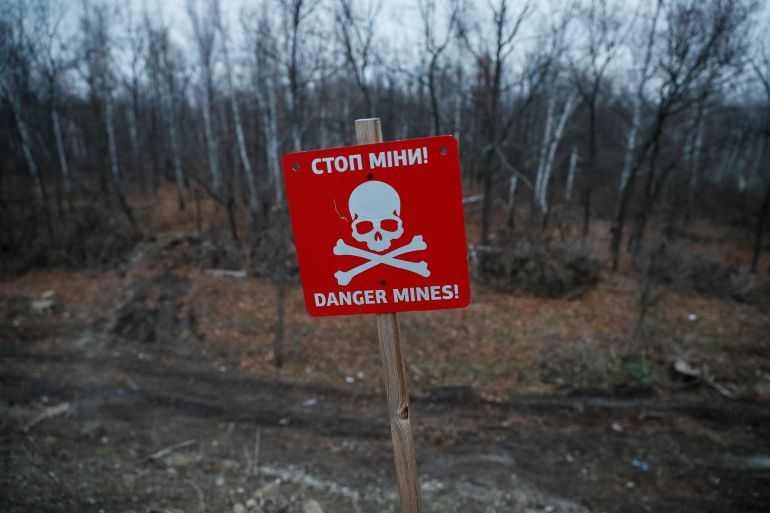The world needs a new solution to its landmine problem
A landmine-free world should be the United Nations’ 18th Sustainable Development Goal.

Eight years after war started in eastern Ukraine and six months after Russia launched a full-scale invasion, Kyiv is facing a major mining problem. With an estimated 160,000 square kilometres contaminated by landmines, Ukraine is now one of the world’s most heavily mined countries. To put that in perspective, that is an area almost double the size of Ireland.
The United States has led the effort to tackle this leviathan issue, pledging $89m to fund 100 anti-mining teams in Ukraine for the next year. This is a concrete move that will see some results. But it will not be enough. A mere $2 to plant, each mine costs up to $1,000 to remove.
Keep reading
list of 4 items‘Triple spending’: Zimbabweans bear cost of changing to new ZiG currency
‘We share with rats’: Neglect, empty promises for S African hostel-dwellers
Thirty years waiting for a house: South Africa’s ‘backyard’ dwellers
To gauge the scale of the problem, look to the Karabakh region in the South Caucasus. In the early 1990s, it became one of the most intensely-mined areas on Earth after the first Nagorno-Karabakh War between Azerbaijan and Armenia. A conflict in late 2020 reversed much of the territory the former had lost in the first conflict – and granted it access to mine-strewn lands. Azerbaijan has since begun making the liberated territories safe for post-conflict reconstruction. To date, 514sq km have been cleared. For those involved in the industry, this may sound impressive, but 11,270sq km still remain uninhabitable.
The problem with mine clearance is the cost. Azerbaijan is better economically placed than most to fund activities and still, it could only clear 514sq km in two years. In general, the countries that need demining the most are those least able to afford it, as conflicts that contaminate territories with landmines also shatter economies. To ensure funding, a landmine-free world should be made a United Nations Sustainable Development Goal (SDG), alongside the 17 interlinked global goals to be achieved by 2030.
This idea was put forward and discussed at the Humanitarian Conference on Mine Action, organised by the Azerbaijan Mine Action Agency and the United Nations Development Programme (UNDP) in Baku earlier this year. Current international treaties are not enough, nor are national programmes.
According to a report by the demining monitor Mine Action Review, only 153.4sq km were cleared across the world in 2020. It also rated less than a quarter of national demining programmes as “good” or “very good”; the rest were too underfunded to make any significant progress. That does not bode well for Ukraine.
However, if demining is given SDG status, the benefits would be felt immediately. First, this designation would help coordinate global efforts, bring access to international financial mechanisms and ease the burden on underfunded national programmes.
Second, an SDG status would help to ring-fence that funding, putting budgets for demining on the same footing as, for instance, education development programmes. In a post-war, post-COVID setting where funds are limited, this is critical.
Third, SDGs attract more funding for research and development, as we have seen with efforts to promote clean energy and sustainable cities. Simply throwing money at demining is not enough: the cost per unit for removal needs to come down.
However, perhaps the strongest argument for making a mine-free world an SDG is the simplest: it should be. In areas contaminated with mines, development, let alone sustainable development, is impossible.
According to a 2017 joint study by the Geneva International Centre for Humanitarian Demining and the UNDP, mine action is of direct relevance to 12 of the UN’s existing SDGs, while indirectly supporting another four. Take SDG number two: to end hunger, achieve food security and achieve sustainable agriculture. Where mines cover large swathes of farmland – as they do in Ukraine – they directly impact a country’s ability to produce its own food. Or take SDG number four: to ensure equitable and inclusive education. Mined areas can make it much more difficult for children to reach school and even educational facilities themselves may be mined during a conflict. This inevitably impacts school enrolment and access to education.
Landmine-strewn lands are not a new problem. But a new solution is needed. If we are to ever see a world free of them, we need to see them as a social development issue, rather than a technical or military one.
If it can be said that there is a silver lining to the horror we are witnessing in Ukraine, it has thrust the world’s attention back to the critical efforts of demining in conflict and post-conflict zones. That attention should be harnessed to ensure we make it an SDG. After all, SDGs are all interlocking. Without widely supported global demining efforts, there is no hope of achieving the other goals.
The views expressed in this article are the authors’ own and do not necessarily reflect Al Jazeera’s editorial stance.